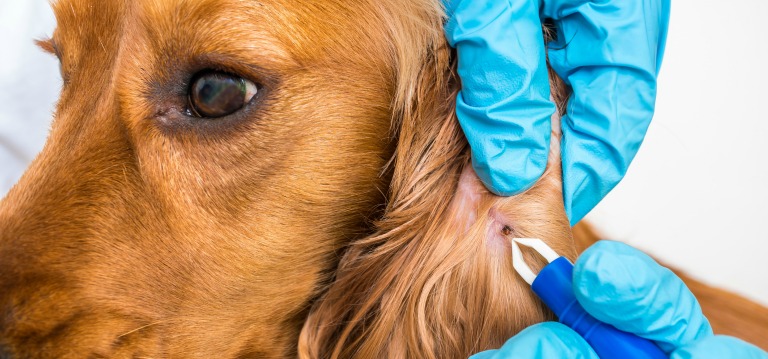If you’re a dog owner, you know a pet can add a lot of fun to your life. Sadly, dogs can fall victim to a loathsome pest: ticks! As ticks tend to be more active when it is warmer, it’s very important to watch out for these blood-feeding critters during the summer and know where to check your dog for ticks to ensure they are not feasting on your four-legged friend.
Have you heard a scary tale about someone finding an engorged tick on a dog and fear you could be next? Read more here about spots to check your dog for ticks, why exactly ticks can be dangerous, and how to remove ticks from your pet.

Have ticks infested your property? Reach out to Ehrlich by calling 888-984-0186 or getting in touch with us online. We can perform the treatment necessary to get rid of ticks around your home.
Where to check your dog for ticks
Because pets spend more time outside than people, their chance of tick exposure is higher than that of humans. You should look for ticks on your dog every day, particularly if it plays in a forest area, in your backyard, or if you take hikes with your pooch.
When inspecting to see whether your furry friend has ticks, you will want to do a thorough examination and make sure to look in certain spots. According to the Centers for Disease Control and Prevention, you should check a pet in the following places:
- In and around your dog’s ears
- Under your dog’s collar
- Between toes
- Around eyelids
- Around its tail

It’s a good idea to check in places where your dog’s skin is thinner, too. Also, remember dogs can carry ticks into your home after playing outdoors in the grass, which is why it is important to check them the moment they come indoors.
Signs of tick disease in dogs
Dogs can contract tick-borne illnesses, such as Rocky Mountain Spotted Fever, Lyme disease, and anaplasmosis. Some diseases could even lead to death if the pet does not get treatment. Talk to your vet if you see any of the following symptoms:
- Reduced appetite
- Fever
- Lethargy
- Joint pain or limping
- Swollen lymph nodes

These signs can be hard to detect and sometimes don’t appear for 7-21 days after the tick bite. As with any abnormal behavior in your pet, it is always important to schedule an appointment with your vet if you notice your dog exhibiting any of the above symptoms.
How to remove a tick from a dog
If you spot a tick on your dog, you need to remove it right away. When you remove the tick more quickly, it’s less likely that a pathogen will be transmitted. Below are the proper steps you should follow to remove a tick from your pet.
- Wash your hands.
- Use tweezers to grasp the tick close to your dog’s skin.
- Pull straight up and do not twist the tick.
- Place the tick in alcohol, flush it down the toilet, or wrap it in tape to get rid of it. Do not crush it.

Ask your vet about how to protect your dog from ticks and what is the best treatment method if the pooch does indeed get ticks. Tick bites can result in severe consequences if the little critters are not eliminated as soon as possible.
Tick species that bite dogs
Ticks bite animals so they can feed on blood. As a pet owner, you should keep in mind the deer tick (a.k.a the black-legged tick), American dog tick, brown dog tick, and lone star tick, as all of these ticks may feed on your dog.
- Brown dog tick – Ticks that have not fed are around ⅛” in length and about ½” after feeding. They are reddish-brown but regions of their bodies can become gray-blue or olive once they have fed.
- American dog tick – Females that haven’t fed are around 3/16” in length and can be as long as ⅝” in length after feeding. They are brown but have white to gray marks.
- Deer tick (black-legged tick) – Females that have not fed are around ⅛” in length. Part of their body is orange-brown in color; however, the abdomen becomes darker when they have fed.
- Lone star tick – Adult females that have not fed are about ⅛” in length but once they have fed, they can be as long as around 7/16”. They are reddish-brown but gray after feeding.

Ehrlich gets rid of ticks
Although you may do your best to prevent ticks, your furry friend may still get them. If that happens, consult your veterinarian. For further protection, Ehrlich can also treat the area around your home for ticks with our mosquito and tick control service!
This service will eliminate adult mosquitoes and ticks while controlling tick larvae and nymphs. It helps reduce exposure to these biting pests in your yard and the health risks they pose for both you and your pets. Get in touch today to set up a time for a tick expert to conduct an inspection!




